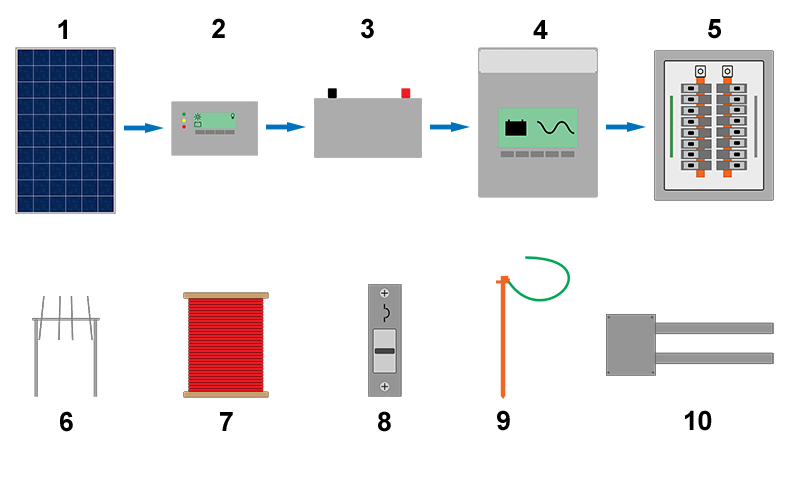Basic stand-alone PV system components
Stand-alone PV systems, regardless of where one is at in the world, share the same basic components. This article will give a high level overview with links to more detailed information on each component.
Contents
PV source
A PV system has one or more modules - Category:PV source - that convert the energy of the sun into electrical current. Solar PV modules use the photovoltaic (PV) effect to generate electrical current upon exposure to light. If there are multiple modules in the system, they are typically arranged into what is referred to as an array. The term array may be used for simplicity even if there is only one module in the system.
Energy storage
A stand-alone PV system requires some type of energy storage system - Category:Energy storage - in order to provide energy at night or during periods of bad weather. If there are multiple batteries in a system they are arranged together into what is referred to as a battery bank. The term battery bank may be used for simplicity even if there is only one battery in the system.
Charge controller
A charge controller - Category:Charge controller - or an inverter-charger Category:Inverter is essential as batteries have specific charging requirements and proper charging is essential to ensuring that they have a long life. A system may have multple parallel charging sources.
Inverter
In order to power alternating current loads, it is necessary to have an inverter - Category:Inverter in a stand-alone system. The battery bank provides a stable voltage and current to the inverter, which it can then convert into stable alternating current to supply AC loads.
Mounting system
PV modules must be anchored to some type of mounting system - Category:Mounting system - to ensure that their production is maximized with the correct orientation and angle relative to the sun, but also to ensure that they are not damaged by weather.
Wire
All of the different electrical components of a system need to be connected together with wire - Category:Wire - that is appropriate for the voltage, current and conditions to which it will be subjected.
Overcurrent protection
All wires have a maximum rated current that they can handle and must be protected by an overcurrent protection device - Category:Overcurrent protection - if they could potentially be exposed to current that exceeds this capacity. Otherwise, an electrical fire can result. The most common overcurrent protection devices are breakers and fuses.
Grounding system
A properly built grounding system - Category:Grounding ensures safety for users and protections the system equipment against damage from lightning. Small PV systems often do not incorporate a grounding system due to cost, but the benefit of proper grounding increases as system size and cost increases.
Physical wire protection
If a wire could potentially be damaged by the conditions in which it is installed, weather, rodents, building occupants or any other source , it is necessary to protect the wire - Category:Physical wire protection
